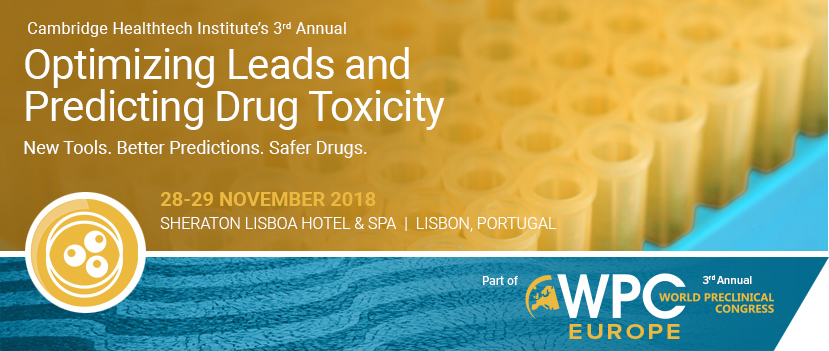
There have been rapid changes in technology and approaches being utilized to bring safer and more effective drugs to the clinic. Despite those efforts, adverse drug events such as cardiotoxicity, hepatotoxicity and other organ toxicities, keep surfacing
in the clinic and idiosyncratic drug toxicity continues to haunt the drug development process. What can scientists do to ensure that the lead compounds are optimized and validated early and accurately to avoid costly mistakes from happening later
in drug development? Cambridge Healthtech Institute’s 3rd Annual Optimizing Leads and Predicting Drug Toxicity conference looks at the scientific and technical advancements being made to better optimize
drug candidates and accurately predict drug-related toxicities. What assays and models are being used, how physiologically relevant are they, how reliable and predictable is the data, and how is this information translated into knowledge that can
impact decision-making? Hear experiences shared by experts and join the interactive sessions and panel discussions for active networking, brainstorming and collaborating.
Final Agenda
Day 1 | Day 2 | Download Brochure
Recommended All Access Package:
27 November: Organ-on-a-Chip and MicroPhysiological Systems
27 November Dinner Course: SC2: Understanding Key Concepts in Drug Metabolism and Drug Transport
28-29 November: Optimizing Leads and Predicting Drug Toxicity
29-30 November: 3D Cellular Models
29 November Dinner Course: SC5: Humanized Mouse Models: Technology and Applications in Preclinical Assessment of Cancer Immunotherapy
Wednesday 28 November
7:00 Registration and Morning Coffee
8:50 Welcome Remarks
Tanuja Koppal, PhD, Conference Director, Cambridge Healthtech Institute
8:55 Chairperson’s Remarks
Bernard Faller, PhD, Director, PK Sciences-In vitro ADME, Novartis Institutes for BioMedical Research
9:00 Transport Systems: Victims or Perpetrators in Drug Safety?
 Bruno Stieger, PhD, Department of Clinical Pharmacology and
Toxicology, University Hospital Zurich, Zurich, Switzerland
Bruno Stieger, PhD, Department of Clinical Pharmacology and
Toxicology, University Hospital Zurich, Zurich, Switzerland
Adverse drug actions are typically caused after the drugs have entered the cells. This is the standard situation, where drug transporting uptake systems act as perpetrators of adverse drug action. Outside of the cells, drug uptake may be impaired by drug-drug
interactions and lead to pharmacokinetic drug-drug interactions with uptake systems being victims. At epithelial barriers like the intestine, drugs may interfere with efflux systems, e.g., which become victims. In hepatocytes, drugs or their metabolites
can also interfere with the canalicular efflux of bile salts, making BSEP a victim.
9:30 Screening Strategies for Cellular Uptake
 Bernard Faller, PhD, Director, PK Sciences-In vitro ADME, Novartis
Institutes for BioMedical Research
Bernard Faller, PhD, Director, PK Sciences-In vitro ADME, Novartis
Institutes for BioMedical Research
Intra-cellular concentration is an important parameter to assess target engagement, especially for teams working outside the traditional LMW property space where permeability might be rate-limiting. What are the assays that can be used to assess intracellular
concentration? How long does one need to incubate? How can one most effectively remove non-specific binding? How are efflux and uptake transporters shifting the equilibrium between medium and intra-cellular compartments?
10:00 Grand Opening Coffee Break in the Exhibit Hall with Poster Viewing
10:45 Reactive Drug Metabolites in Safety Testing of Novel Drug Candidates
 Christine K. Maurer, PhD, Head of Laboratory Discovery Biotransformation,
Research & Development, Global Early Development, Merck KGaA
Christine K. Maurer, PhD, Head of Laboratory Discovery Biotransformation,
Research & Development, Global Early Development, Merck KGaA
Many drugs withdrawn from the market undergo bioactivation to reactive metabolites (RMs). These can form covalent bonds to proteins and/or DNA potentially leading to organ toxicity and/or carcinogenesis. Thus, detection, risk minimization, and integrated
risk assessment of RM formation is important in drug discovery and development. In this talk, current methods for RM detection and strategies for risk assessment in oncology projects are discussed in connection with the Merck RM strategy.
11:15 Drug Bioactivation: The Good, The Bad And The Ugly
 Axel Pähler, E.R.T., DMPK/PD Leader, Pharmaceutical Sciences (PS), Roche
Pharmaceutical Research and Early Development, Roche Innovation Center
Axel Pähler, E.R.T., DMPK/PD Leader, Pharmaceutical Sciences (PS), Roche
Pharmaceutical Research and Early Development, Roche Innovation Center
Bioactivation is generally considered a risk factor for drug induced toxicities such as DILI. This presentation will highlight cases of reactive metabolite formation linked to safety failures and the key learnings Pharma has derived from that. Also highlighted
are bioactivation reactions that determine the pharmacological mode of action. In this context learnings from old drug as well as from novel strategies to design selective covalent t inhibitors for safe use will be presented.
11:45 Idiosyncratic Drug Toxicity: Can in silico Tools Predict Bioactivation?
 John C. L. Erve, PhD, DABT, Consultant, Jerve Scientific
Consulting, Inc.
John C. L. Erve, PhD, DABT, Consultant, Jerve Scientific
Consulting, Inc.
Idiosyncratic drug toxicity (IDT) remains a concern to pharmaceutical firms and patients. Bioactivation of drugs to reactive metabolites is integral to the Hapten hypothesis. Bioactivation is traditionally investigated experimentally in vitro together with mass spectrometry. Bioactivation has also be investigated computationally. Approaches include quantum chemical calculations, docking with P450 enzymes and more recently, neural networks. In this talk, in silico approaches will be illustrated using drugs that have caused IDT.
12:15 Enjoy Lunch on Your Own
13:45 Chairperson’s Remarks
Danilo A. Tagle, PhD, Associate Director for Special Initiatives, National Center for Advancing Translational Sciences, National Institutes of Health
13:50 Use of a Quantitative Systems Pharmacology (QSP) Model to Predict Liver Toxicity in Simulated Populations
 Christina Battista, PhD,
Postdoctoral Fellow, University of North Carolina Institute for Drug Safety Sciences
Christina Battista, PhD,
Postdoctoral Fellow, University of North Carolina Institute for Drug Safety Sciences
DILIsym®, the result of an ongoing public-private partnership, has been developed to investigate drug-induced liver injury (DILI). The model employs mathematical representations of mechanistic interactions following drug administration through the
release of serum biomarkers to accurately predict clinical observations in simulated patient populations. This talk will outline DILIsym and discuss applications to date.
14:20 On-/Off-Target and Class Effects of Different Biological Classes and How to Use Them for in silico Modelling of Biologics
 Alexander Amberg, PhD, Computational Toxicologist,
R&D Preclinical Safety, Sanofi
Alexander Amberg, PhD, Computational Toxicologist,
R&D Preclinical Safety, Sanofi
A wide variety of biotherapeutic modalities are used as drugs, many of them are a relatively new class of therapeutics. There is an uncertainty regarding the adverse effects of the different biological classes, for some people they are just a result of
exaggerated pharmacology. This presentation will summarize results of an analysis of on-/off-target and class effects of different biological classes and will try to answer the question if and how they could be used for in silico modelling approaches of biologics.
14:50 Interactive Breakout Discussion Groups - View Details
This session features various discussion groups that are led by a moderator/s who ensures focused conversations around the key issues listed. Attendees choose to join a specific group and the small, informal setting facilitates sharing of ideas and active
networking.
Drug Bioactivation: The Good, The Bad and The Ugly
Moderator:Axel Pähler, E.R.T., DMPK/PD Leader, Pharmaceutical Sciences (PS), Roche Pharmaceutical Research and Early Development, Roche Innovation Center
- Bioactivation as a risk factor for drug induced toxicities such as DILI
- Case studies of reactive metabolite formation linked to safety failures and key learnings
- Bioactivation reactions that determine the pharmacological mode of action
- Key learnings from old drugs and novel strategies to design selective new inhibitors for safe use
Use of Modeling Tools and Strategies for Predicting ADME-Tox Properties
Maria A. Miteva, PhD, Research Director, Molécules Thérapeutiques in silico (MTi), Inserm Institute
- Machine-learning or structure-based approaches for ADME-Tox prediction and optimization?
- Should the modeling tools for toxicity predicting be specific for xenobiotics and drugs?
- Quantum-mechanics methods for drug metabolism prediction
16:00 Refreshment Break in the Exhibit Hall with Poster Viewing
16:45 Microphysiological Systems for Safety and Efficacy Studies
 Danilo A. Tagle, PhD, Associate Director for Special Initiatives, National
Center for Advancing Translational Sciences, National Institutes of Health
Danilo A. Tagle, PhD, Associate Director for Special Initiatives, National
Center for Advancing Translational Sciences, National Institutes of Health
Approximately 30% of drugs have failed in human clinical trials due to adverse reactions despite promising pre-clinical studies, and another 60% fail due to lack of efficacy. The NIH Tissue Chips program is developing alternative approaches for more
reliable readouts of toxicity or efficacy during drug development. Tissue chips are bioengineered microphysiological systems utilizing chip technology and microfluidics that mimic tissue cytoarchitecture and functional units of human organs. These
microfabricated devices are useful for modeling human diseases, and for studies in precision medicine and environment exposures.
17:15 Development of Quantitative Systems Pharmacology (QSP) for Improved Association of Preclinical and Clinical Treatment Phenotypes
 Bérengère Dumotier, PhD, Secondary Pharmacology Expert, Safety
Pharmacology, Novartis Pharma AG
Bérengère Dumotier, PhD, Secondary Pharmacology Expert, Safety
Pharmacology, Novartis Pharma AG
Inadequate balance between therapeutic efficacy and adverse events is a major reason for high attrition rates. Majority of adverse events are related to undesirable drug pharmacology (off-target pharmacology, complex pharmacokinetics), and disease-specific
pathophysiology of patients. Off-target engagements can be determined at the very early phase of drug discovery processes; however, their translation to AEs is dependent on the two other components mentioned above. The talk will focus on the best
way to integrate preclinical and clinical data for small molecules, into a knowledge-based platform for preclinical risk mitigation.
17:45 Summary of Breakout Discussions
Axel Pähler, E.R.T., DMPK/PD Leader, Pharmaceutical Sciences (PS), Roche Pharmaceutical Research and Early Development, Roche Innovation Center
Maria A. Miteva, PhD, Research Director, Molécules Thérapeutiques in silico (MTi), Inserm Institute
18:15 Welcome Reception in the Exhibit Hall with Poster Viewing
19:15 Close of Day
Day 1 | Day 2 | Download Brochure
Thursday 29 November
8:00 Registration and Morning Coffee
8:25 Chairperson’s Remarks
Chris Denning, PhD, Professor and Head, Department of Stem Cell Biology, University of Nottingham
8:30 Importance of Phenotyping Your Model to Know What Purpose It Is Fit For:
Focus on Increasing Complexity of In vitro Models
Praveen Sharma, PhD, Lecturer, Molecular and Clinical Pharmacology, Institute of Translational Medicine, University of Liverpool
Focus on Mitotoxicity
Amy Chadwick, PhD, Lecturer, Molecular and Clinical Pharmacology, Institute of Translational Medicine, University of Liverpool
It is estimated that 38% and 51% of compounds showing liver injury in man do not show similar effects in animals. The work of the IMI MIP-DILI and TransQST consortia shows how a roadmap is being developed based for the integration of established and
emerging test systems and illustrates the increasing complexity of models from 2D to multi-cell 3D systems that are used in a logical fashion to assess DILI liabilities of new drugs before they are given to man.
9:00 Bioengineering Human Pluripotent Stem Cell Derived 3D Models for Drug Toxicity and Disease Modeling
Paula M. Alves, PhD, Unit Director, Cell Bioprocesses Laboratory, Instituto de Biologia Experimental e Tecnologica (iBET)
The development and validation of human in vitro models with physiological relevance, robustness, reproducibility and scalability are still a need in toxicology. Our strategy combines human stem cells, 3D culture
strategies and computer-controlled bioreactors in perfusion operation modes. Results concerning the establishment and refinement of culture systems for efficient stem cell differentiation and maturation into cardiac, neural and hepatic cells,
as well as their applicability for long-term toxicity testing will be presented and discussed.
 9:30 Rethinking the Translational – The use of Highly Predictive hiPSC-Derived Models in Pre-clinical Drug Development
9:30 Rethinking the Translational – The use of Highly Predictive hiPSC-Derived Models in Pre-clinical Drug Development
 Alexandre Fouassier, Business Development &
Sales, Southern Europe, NCardia
Alexandre Fouassier, Business Development &
Sales, Southern Europe, NCardia
Current drug development strategies are failing to increase the number of drugs reaching the market. One reason for low success rates is the lack of predictive models. Join our talk to learn how to implement a predictive and translational in-vitro disease model, and assays for efficacy screening at any throughput.
10:00 Coffee Break in the Exhibit Hall. Last chance for poster viewing.
10:45 Exploring the Relationship Between Myofilament Calcium and Force Production in the Single iPS-Cardiomyocytes
 Matthew J Daniels MA PhD, MRCP, Wellcome Trust Intermediate
Clinical Fellow, Principal Investigator, Division of Cardiovascular Medicine, and BHF Oxbridge Centre of Regenerative Medicine, Oxford University
Matthew J Daniels MA PhD, MRCP, Wellcome Trust Intermediate
Clinical Fellow, Principal Investigator, Division of Cardiovascular Medicine, and BHF Oxbridge Centre of Regenerative Medicine, Oxford University
The in vitro survival of iPS-CMs should aid cardiotoxicity studies of contractility. As contraction depends on depolarisation, both parameters should be measured in these assays. We find that all classes of chemical
dye (voltage, calcium and sodium) impair contractility, and when used in combination with drugs known to act on the myofilament produce confusing composite results making them unreliable for this purpose. We describe how we have overcome this
problem.
11:15 Phenotypic Analysis for Cardiotoxicity Evaluation on Human iPSC
 Anthony Perrier, PhD, Study Director, In vitro Toxicology,
Biologie Servier
Anthony Perrier, PhD, Study Director, In vitro Toxicology,
Biologie Servier
To improve the early prediction of cardiac toxicity, we developed in vitro tests using High Content Analysis using human iPSC cardiomyocytes. The readouts were qualified using Receiver Operating Characteristic curves
and a ranking algorithm was developed to obtain an overall multiparametric cardiotoxicity evaluation for each compound. This cardiotoxicity phenotypic analysis and ensuing improvements will be used for early safety evaluation in the drug development
process at Servier.
11:45 Evaluating Cardiovascular Liability and Genetic Disease with hiPSC-Cardiomyocytes
 Chris Denning, PhD, Professor and Head, Department of Stem Cell
Biology, University of Nottingham
Chris Denning, PhD, Professor and Head, Department of Stem Cell
Biology, University of Nottingham
We will review the results from a public-private partnership (NC3Rs-GSK), termed the “CRACK-IT InPulse Challenge” and the software developed to facilitate analysis of cardiac contractility. This sought to evaluate hiPSC-cardiomyocytes
in 2D and 3D formats in the blinded evaluation of 28 drugs that were associated with positive or negative inotropy in heart tissue, or no effect. Finally, we will show data on the coupling of hiPSC-CMs and Cas9/CRISPR-mediated gene editing to
model hypertrophic cardiomyopathy.
12:15 Close of Conference
Day 1 | Day 2 | Download Brochure